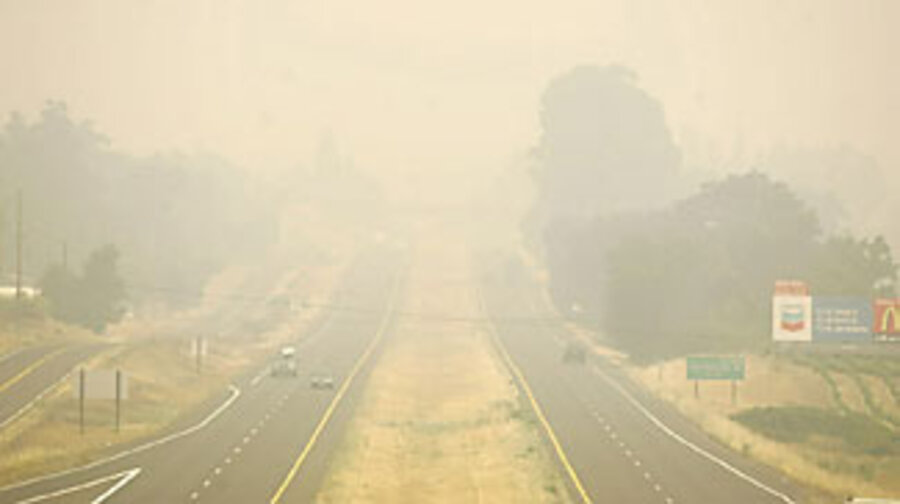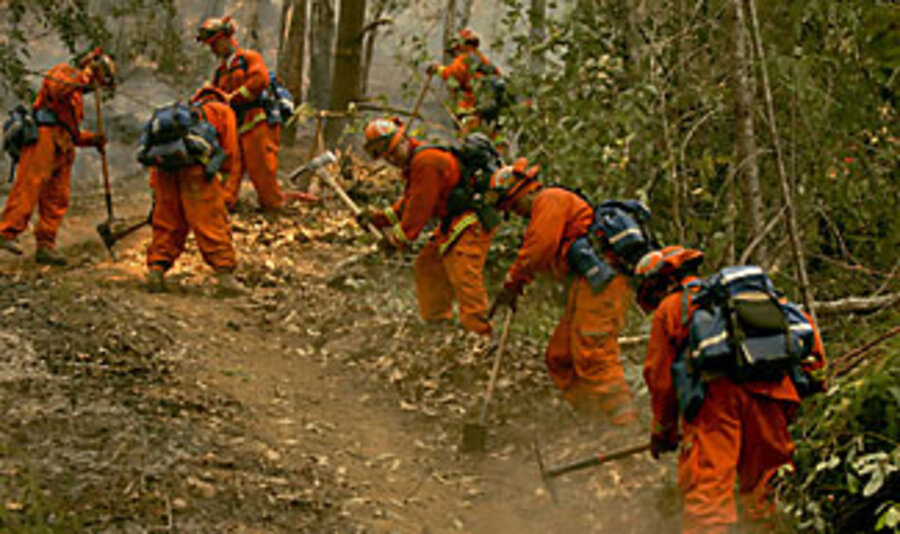California wildfires spark call to boost resources
Loading...
| Oakland, Calif.
It's early in the summer for California's firefighters to be outgunned, but it's an increasingly common situation in recent years.
More than a thousand fires are burning across northern California's wildlands, forcing federal, state, and local firefighters to make tough triage decisions. With homes and human life as first priorities, at least one local timber company has had to hire its own private firefighters.
Now, fire chiefs are sounding the alarm about the chronic shortfalls in resources. A blue-ribbon panel last week called on the state to add more trucks, helicopters, and fully staffed teams to its fire arsenal.
Gov. Arnold Schwarzenegger supports beefing up the forces. But he's proposing to pay for it with higher fees on homeowners in fire-prone areas, reflecting concerns here that wildlands development lies at the root of the problem.
"Just having more trucks once the fire has started is like saying the solution to healthcare in America is to have more emergency rooms," says Bill Stewart, a forestry specialist at the University of California in Berkeley.
He has studied building patterns in the so-called wildland-urban interface. New housing there has been popping up almost twice as fast in unincorporated areas than within city limits, he says. "A lot of houses out there are in places that don't have a well-funded local fire department, and they are just hoping the state has enough resources to come and help fight the fire," he says.
Increasingly, the state does not.
Two recent years saw such massive fires that backup resources for other emergencies grew thin. "It was very, very close to the edge in 2003 and in 2007," says Carroll Wills, spokesperson for the California Professional Firefighters (CPF). Another big fire, or other disaster, "could have popped the circuit breaker," he says. "They were stretched to the max."
When major wildfires strike, California turns into one big fire department, with local stations sending crews up and down the state. The real shortfall is often equipment, says Lou Paulson, president of the CPF. Local jurisdictions can part with manpower but not trucks.
"There's more resources needed because you've got to protect more structures [with urban sprawl]," says Mr. Paulson. Drought conditions have not helped, either. "There's definitely a change in the climate here ... the fire season has become year-round," he says.
This year is shaping up to be another doozy. Dryness levels already resemble August, says Paulson.
A lightning storm more than a week ago triggered over a thousand fires in northern California, accounting for most of the state's current 1,345 fires. Some 18,000 fire personnel are battling the blazes. Other states have sent teams and at least six National Guard tanker planes. Federal relief is in sight with President Bush declaring an emergency Saturday.
Visiting the coastal community of Big Sur, the scene of more fires, Governor Schwarzenegger urged Californians to lay off holiday fireworks.
The situation also prompted the Blue Ribbon Task Force, a panel of fire chiefs originally convened by the governor after the 2003 fires, to remind lawmakers of their call for 150 new engines, additional helicopter upgrades, and more staff. The task force also has long-term suggestions, including national wildland fire insurance and more local regulation of land use.
The governor has proposed paying for much of the new equipment with an insurance surcharge on residential and commercial property. Those located in high-risk zones for fire, flood, or earthquake will pay 1.4 percent; everyone else 0.75 percent.
With an estimated $15 billion state budget deficit, finding new revenues for additional spending has grown paramount. The task force supports the surcharge, so long as it goes to new equipment.
Insurance companies themselves are getting more proactive. AIG Private Client Group provides "wildfire protection units" to 3,200 Western clients whose homes would cost at least $1 million to replace. Under the program, AIG sends out trucks to spray the perimeter of a property with fire retardant ahead of fire season. Then, the company monitors wildfire activity. If fire threatens a home, another truck is sent to spray the house.
"It's by no means a private fire service. We don't go in there if a house is on fire and try to put the fire out," says AIG spokesperson Peter Tulupman.
Private companies offering similar services are sprouting up across the West. One such company, Pacific Fire Guard, started services this year in southern California. Customers pay roughly $1,800 for a typical 3,000-square-foot home.
The trend signals a recognition that those who take on more risk may need to pay a premium for it, says Keith Gilless, a UC Berkeley professor of forest economics.
"There's a balance between what level of investment we want to make in fire protection as part of our overall investment in public safety, and what responsibility we want the owners of homes in risky areas to accept," says Dr. Gilless.






